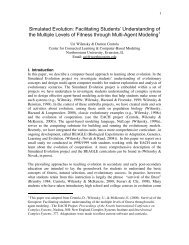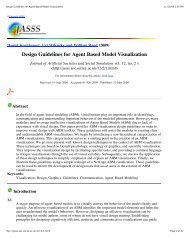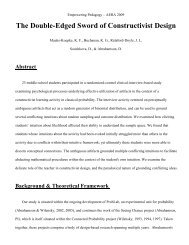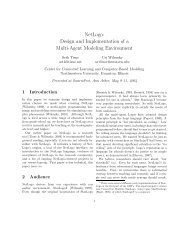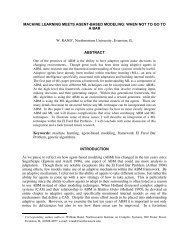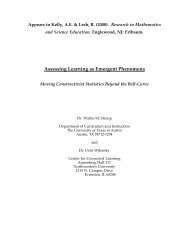Finding Forms of Flocking - The Center for Connected Learning and ...
Finding Forms of Flocking - The Center for Connected Learning and ...
Finding Forms of Flocking - The Center for Connected Learning and ...
Create successful ePaper yourself
Turn your PDF publications into a flip-book with our unique Google optimized e-Paper software.
<strong>Finding</strong> <strong>Forms</strong> <strong>of</strong> <strong>Flocking</strong>: Evolutionary Search<br />
in ABM Parameter-Spaces<br />
Forrest Stonedahl <strong>and</strong> Uri Wilensky<br />
<strong>Center</strong> <strong>for</strong> <strong>Connected</strong> <strong>Learning</strong> <strong>and</strong> Computer-Based Modeling<br />
Northwestern University, Evanston, IL, USA<br />
<strong>for</strong>rest@northwestern.edu, uri@northwestern.edu<br />
Abstract. While agent-based models (ABMs) are becoming increasingly<br />
popular <strong>for</strong> simulating complex <strong>and</strong> emergent phenomena in many<br />
fields, underst<strong>and</strong>ing <strong>and</strong> analyzing ABMs poses considerable challenges.<br />
ABM behavior <strong>of</strong>ten depends on many model parameters, <strong>and</strong> the task <strong>of</strong><br />
exploring a model’s parameter space <strong>and</strong> discovering the impact <strong>of</strong> different<br />
parameter settings can be difficult <strong>and</strong> time-consuming. Exhaustively<br />
running the model with all combinations <strong>of</strong> parameter settings is generally<br />
infeasible, but judging behavior by varying one parameter at a time<br />
risks overlooking complex nonlinear interactions between parameters. Alternatively,<br />
we present a case study in computer-aided model exploration,<br />
demonstrating how evolutionary search algorithms can be used to probe<br />
<strong>for</strong> several qualitative behaviors (convergence, non-convergence, volatility,<br />
<strong>and</strong> the <strong>for</strong>mation <strong>of</strong> vee shapes) in two different flocking models. We<br />
also introduce a new s<strong>of</strong>tware tool (BehaviorSearch) <strong>for</strong> per<strong>for</strong>ming parameter<br />
search on ABMs created in the NetLogo modeling environment.<br />
Key words: parameter search, model exploration, genetic algorithms,<br />
flocking, agent-based modeling, ABM, multi-agent simulation<br />
1 Motivation<br />
Agent-based modeling is a powerful simulation technique in which many agents<br />
interact according to simple rules resulting in the emergence <strong>of</strong> complex aggregatelevel<br />
behavior. This technique is becoming increasingly popular in a wide range<br />
<strong>of</strong> scientific endeavors due to the power it has to simulate many different natural<br />
<strong>and</strong> artificial processes [1, 3, 22]. A crucial step in the modeling process is an analysis<br />
<strong>of</strong> how the system’s behavior is affected by the various model parameters.<br />
However, the number <strong>of</strong> controlling parameters <strong>and</strong> range <strong>of</strong> parameter values<br />
in an agent-based model (ABM) is <strong>of</strong>ten large, the computation required to run<br />
a model is <strong>of</strong>ten significant, <strong>and</strong> agent-based models are typically stochastic in<br />
nature, meaning that multiple trials must be per<strong>for</strong>med to assess the model’s<br />
behavior. <strong>The</strong>se factors combine to make a full brute-<strong>for</strong>ce exploration <strong>of</strong> the<br />
parameter space infeasible. Researchers respond to this difficulty in a variety<br />
<strong>of</strong> ways. One common approach is to run factorial-design experiments that either<br />
explore model behavior only in a small subspace or explore the full space
ut with very low resolution (which may skip over areas <strong>of</strong> interest). A second<br />
common approach is to vary only a single parameter at a time, while holding<br />
the other parameters constant, <strong>and</strong> observe the effect <strong>of</strong> changing each parameter<br />
individually. However, because ABMs <strong>of</strong>ten constitute complex systems with<br />
non-linear interactions, these methods risk overlooking parameter settings that<br />
would yield interesting or unexpected behavior from the model.<br />
As an alternative, we argue that many useful model exploration tasks may<br />
instead be productively <strong>for</strong>mulated as search problems by designing appropriate<br />
objective functions, as we will demonstrate by example in the domain <strong>of</strong><br />
simulated flocking behavior. In this paper, we introduce a new s<strong>of</strong>tware tool<br />
(BehaviorSearch) that we have created <strong>for</strong> the purpose <strong>of</strong> searching/exploring<br />
ABM parameter spaces. Using BehaviorSearch, we <strong>of</strong>fer a case study showing<br />
how search-based exploration can be used to gain insight into the behavior <strong>of</strong><br />
two ABMs <strong>of</strong> flocking that have been implemented in the NetLogo modeling<br />
environment [21, 18]. We also provide a comparison <strong>of</strong> the per<strong>for</strong>mance <strong>of</strong> three<br />
different search algorithms on several exploratory tasks <strong>for</strong> these two ABMs. In<br />
particular, we will show how genetic algorithms <strong>and</strong> hill-climbing can be used to<br />
discover parameter settings <strong>for</strong> these models that yield behaviors such as convergence,<br />
non-convergence, volatility, <strong>and</strong> specific flock shape <strong>for</strong>mation. This<br />
approach can be useful <strong>for</strong> researchers to better underst<strong>and</strong> the models they<br />
have created, the range <strong>of</strong> behavior their models are capable <strong>of</strong> producing, <strong>and</strong><br />
which parameters have large impact on which behaviors. <strong>Flocking</strong> behaviors<br />
were chosen <strong>for</strong> this case study because flocking is a well-known example <strong>of</strong> a<br />
successful agent-based model, <strong>and</strong> can demonstrate a wide range <strong>of</strong> behaviors<br />
depending on the controlling parameters.<br />
2 Related Work<br />
Rather than using a full factorial experiment design <strong>for</strong> sampling points in the<br />
space, several more sophisticated sampling algorithms exist (e.g. Latin hypercube<br />
sampling, sphere-packing). <strong>The</strong>se algorithms stem from the design <strong>of</strong> experiments<br />
(DoE) literature or more specifically the more recent design <strong>and</strong> analysis<br />
<strong>of</strong> computer experiments (DACE) literature (see [14] <strong>for</strong> a discussion <strong>of</strong> applying<br />
DACE methodology to ABMs). While appropriate experimental designs provide<br />
efficient sampling <strong>of</strong> the space in some situations, this is a separate direction<br />
from the search-oriented approach that we are pursuing here. In particular, we<br />
are interested in the use <strong>of</strong> genetic algorithms [7] (GAs) to search the ABM parameter<br />
spaces <strong>for</strong> behaviors <strong>of</strong> interest. Genetic algorithms have proven to be<br />
quite successful on a wide range <strong>of</strong> combinatorial search <strong>and</strong> optimization problems,<br />
<strong>and</strong> are thus a natural meta-heuristic search technique <strong>for</strong> this task. <strong>The</strong>re<br />
is prior work on parameter-search <strong>and</strong> exploration in ABM, <strong>and</strong> considerably<br />
more on the problem <strong>of</strong> parameter-search in general.<br />
Calvez <strong>and</strong> Hutzler have previously used a genetic algorithm (GA) to tune<br />
parameters <strong>of</strong> an ant <strong>for</strong>aging model [4], <strong>and</strong> discuss some <strong>of</strong> the relevant issues<br />
<strong>for</strong> applying GAs to ABM parameter search. However, in this case, the GA’s
per<strong>for</strong>mance was not compared to any other method, <strong>and</strong> the effectiveness <strong>of</strong><br />
GAs <strong>for</strong> the ABM parameter search task has not been thoroughly investigated.<br />
Our present work contributes toward this goal. Specifically, we compare the per<strong>for</strong>mance<br />
<strong>of</strong> a genetic algorithm against a stochastic mutation-based hill-climber,<br />
as well as uni<strong>for</strong>m r<strong>and</strong>om search, to serve as a baseline <strong>for</strong> comparison. We also<br />
explore a different domain (i.e. flocking models rather than ant <strong>for</strong>aging), <strong>and</strong><br />
thus provide another perspective on the issue <strong>of</strong> automated model exploration.<br />
Genetic algorithms have also been used to attempt to calibrate agent-based<br />
models with aggregate-level equation-based models as part <strong>of</strong> the SADDE methodology<br />
[15] <strong>for</strong> designing ABMs. Our research places an emphasis on exploration,<br />
as opposed to calibration or model design. <strong>The</strong> modeler may pose a question<br />
about the model’s behavior which are potentially interesting, <strong>and</strong> the distribution<br />
<strong>of</strong> search results should answer that question, <strong>and</strong> may give additional<br />
insight into the interaction between parameters as well.<br />
Other methods <strong>of</strong> exploration (besides genetic algorithms) have previously<br />
been considered. Most notably, Brueckner <strong>and</strong> Parunak proposed a meta-level<br />
multi-agent system to adaptively select points in the parameter-space to evaluate<br />
[2]. This swarm-based approach resembles particle swarm optimization [8] in<br />
that it uses a population <strong>of</strong> agents that combine global <strong>and</strong> local in<strong>for</strong>mation to<br />
choose a direction to move in the search space, but it also considers whether to<br />
run additional simulations to improve the confidence <strong>of</strong> results at locations in the<br />
space. Brueckner <strong>and</strong> Parunak also mention in passing that genetic algorithms<br />
would be an appropriate choice <strong>for</strong> this type <strong>of</strong> search problem, but they did not<br />
follow this path, <strong>and</strong> only <strong>of</strong>fer results from the novel multi-agent optimization<br />
algorithm they proposed. A comparison <strong>of</strong> genetic algorithms with this, <strong>and</strong><br />
other swarm-based approaches, would be an interesting area <strong>for</strong> future work.<br />
Genetic algorithms have also been employed in parameter-search problems<br />
which are not ABM, but closely related fields. For instance, genetic algorithms<br />
have been applied to search <strong>for</strong> rules in cellular automata (CA) that will produce<br />
a certain behavior (e.g. density classification) [11]. Cellular automata models<br />
could be considered a highly restricted case <strong>of</strong> agent-based models, <strong>and</strong><br />
the cell state transition rules could perhaps be considered the parameters <strong>of</strong><br />
such models, in which case this would constitute searching the parameter space.<br />
However, agent-based simulations more typically have numeric parameters, <strong>and</strong><br />
whereas CA rules are naturally represented by binary switches, <strong>and</strong> the densityclassification<br />
task is closer to a multi-agent system coordination problem, rather<br />
than an agent-based simulation.<br />
Our present investigation is also inspired by Miller’s work on active non-linear<br />
testing [9], which demonstrated the use <strong>of</strong> meta-heuristic optimization (genetic<br />
algorithms <strong>and</strong> hill climbers) <strong>for</strong> searching the parameter-space <strong>of</strong> the World3<br />
simulation, a well-known system dynamics model (SDM). Our work departs from<br />
Miller’s in two respects: 1) model stochasticity (which is less frequently present<br />
in SDMs) is not addressed in those experiments, <strong>and</strong> 2) the characteristics <strong>of</strong><br />
search spaces produced by agent-based models likely differ from those which are<br />
produced by aggregate equation-based models.
3 Methods<br />
3.1 <strong>Flocking</strong> Models Overview<br />
For our case study we explore the parameter-space <strong>of</strong> two agent-based models,<br />
searching <strong>for</strong> a variety <strong>of</strong> target behaviors. <strong>The</strong> two ABMs are the <strong>Flocking</strong> model<br />
[20] (denoted as <strong>Flocking</strong>) <strong>and</strong> the <strong>Flocking</strong> Vee Formations model [23] (denoted<br />
as <strong>Flocking</strong> VF ). While the parameters <strong>of</strong> these two models are discussed briefly<br />
below, an in-depth discussion <strong>of</strong> these models is beyond the scope <strong>of</strong> this paper.<br />
Thus, we invite interested readers to examine the models themselves, which are<br />
both available in the NetLogo models library.<br />
<strong>Flocking</strong> closely resembles the seminal ABM <strong>of</strong> swarming behavior in artificial<br />
birds (playfully dubbed “boids”) that was introduced by Reynolds as<br />
a way to create life-like cinematic animation <strong>of</strong> flocking birds or other flying/swimming/swarming<br />
creatures [13]. <strong>The</strong> behavior <strong>of</strong> each “boid” is influenced<br />
by three basic rules, which provide impetus toward alignment, coherence,<br />
<strong>and</strong> separation. <strong>The</strong> relative influences <strong>of</strong> each are controlled by the parameters<br />
max-align-turn, max-cohere-turn, <strong>and</strong> max-separate-turn, respectively. Additionally<br />
there are parameters controlling the distance at which birds have knowledge<br />
<strong>of</strong> other birds (vision), <strong>and</strong> the minimum distance <strong>of</strong> separation which birds attempt<br />
to maintain (minimum-separation). For this first model, exploratory search<br />
tasks include the discovery <strong>of</strong> parameters that yield quick directional convergence<br />
(Section 4.1), non-convergence (Section 4.2), <strong>and</strong> volatility <strong>of</strong> the aggregate<br />
flock’s heading over time (Section 4.3).<br />
<strong>Flocking</strong> VF is based loosely on an extension <strong>of</strong> Reynolds’ work that was<br />
proposed by Nathan <strong>and</strong> Barbosa [12], attempting to produce the vee-shaped<br />
patterns <strong>of</strong>ten observed in large migratory birds, such as Canada geese. <strong>Flocking</strong><br />
VF has 8 controlling parameters, which account <strong>for</strong> fine-grained control over<br />
bird vision (vision-distance, vision-cone, obstruction-cone), takes into account benefits<br />
<strong>of</strong> “updraft” from nearby birds (updraft-distance, too-close), as well as flying<br />
speeds <strong>and</strong> acceleration (base-speed, speed-change-factor, <strong>and</strong> max-turn). <strong>The</strong> final<br />
exploratory search task is to seek parameters that best yield V-shaped flock<br />
<strong>for</strong>mations, in both <strong>Flocking</strong> <strong>and</strong> <strong>Flocking</strong> VF (Section 4.4).<br />
3.2 Search Algorithms<br />
For each search task, we tested three different search algorithms: uni<strong>for</strong>m r<strong>and</strong>om<br />
search (RS), a r<strong>and</strong>om-mutation hill climber (HC), <strong>and</strong> a genetic algorithm<br />
(GA). For all <strong>of</strong> the search methods, each ABM parameter’s value was encoded<br />
as a sequence <strong>of</strong> binary digits (bit string) using a Gray code 1 , <strong>and</strong> all the parameters’<br />
bit strings were concatenated to create a string that represents one point<br />
in the parameter-space. A bit string is evaluated by decoding it into the ABM<br />
parameter settings, <strong>and</strong> running the model with those parameters.<br />
1 A high-order binary encoding requires flipping 4 bits to change from 7 (01112) to<br />
8 (10002). In a Gray code, consecutive numbers only require a single bit flip, thus<br />
creating a smoother mapping from numbers into binary search spaces.
<strong>The</strong> RS method simply generates one r<strong>and</strong>om bit string after another, <strong>and</strong><br />
in the end chooses the one that best elicited the desired model behavior. RS<br />
is a naive search techniques, which we included as a baseline <strong>for</strong> comparison,<br />
to determine whether using more sophisticated meta-heuristics (such as the HC<br />
<strong>and</strong> GA) were indeed helpful.<br />
Our HC is primarily a local search algorithm. It starts with a r<strong>and</strong>om bit<br />
string (s). A new string (snew) is generated from s (each bit <strong>of</strong> s gets flipped with<br />
probability 0.05, which is the mutation-rate). If snew is better than s (generates<br />
behavior that judged closer to the desired target behavior), then the HC chooses<br />
snew as the new s, <strong>and</strong> the process repeats. If the HC becomes stuck (after 1000<br />
unsuccessful move attempts), it will restart at a new r<strong>and</strong>om location in the<br />
search space, which makes this a quasi-local search method.<br />
Our GA is a st<strong>and</strong>ard generational genetic algorithm [7], with a population<br />
size <strong>of</strong> 30, a crossover rate <strong>of</strong> 0.7, <strong>and</strong> a mutation rate <strong>of</strong> 0.05, using tournament<br />
selection with tournament size 3. <strong>The</strong> GA is a more sophisticated search mechanism<br />
than HC or RS, <strong>and</strong> there are several reasons to believe that it might<br />
per<strong>for</strong>m better. First, the GA is population-based, which allows it to explore<br />
multiple regions <strong>of</strong> the space simultaneously (more <strong>of</strong> a global search technique).<br />
Second, genetic algorithms have previously been shown to per<strong>for</strong>m well on a variety<br />
<strong>of</strong> nonlinear <strong>and</strong> multi-modal search/optimization problems. Third, genetic<br />
algorithms (like the biological processes <strong>of</strong> evolution that inspired them) <strong>of</strong>ten<br />
have a way <strong>of</strong> coming up with creative or unexpected solutions to a problem,<br />
which humans would not have considered. However, depending on the how the<br />
search space is structured, simpler approaches may be more effective. For example,<br />
it was shown that a HC per<strong>for</strong>med better on a problem that was specifically<br />
designed with the expectation that GAs would work well on it [10]. One important<br />
consideration, is whether there are so-called building blocks in the solutionspace,<br />
which the GA is able to discover <strong>and</strong> combine (via genetic crossover) to<br />
<strong>for</strong>m better solutions. Phrased at the level <strong>of</strong> the agent-based model, this question<br />
becomes: are there certain combinations <strong>of</strong> several parameter settings, each<br />
<strong>of</strong> which partially produce desired target behavior, <strong>and</strong> when combined together<br />
produce that behavior even more strongly? If so, the GA may be able to take<br />
advantage <strong>of</strong> that structure in the search space to efficiently find solutions.<br />
<strong>The</strong> objective function (or “fitness function” in the parlance <strong>of</strong> evolutionary<br />
computation) was always averaged across 5 model runs (replicates) with different<br />
r<strong>and</strong>om seeds, to reduce variability stemming from model stochasticity. While<br />
this variability is essentially “noise” from the search algorithm’s perspective,<br />
it is simply a reflecting the fact that running the ABM results in a range <strong>of</strong><br />
behavior depending on the initial placement <strong>of</strong> the birds. Our objective functions<br />
are attempting to characterize the presence or absence <strong>of</strong> a certain behavior on<br />
average, <strong>and</strong> short <strong>of</strong> running the simulation with every possible initial condition<br />
(which is impossible), there will always be some uncertainty about the objective<br />
function measure. Taking the average value from several replicate runs <strong>of</strong> the<br />
simulation, however, reduces this uncertainty <strong>and</strong> smooths the search l<strong>and</strong>scape.
<strong>The</strong> objective functions were different <strong>for</strong> each task, <strong>and</strong> will be discussed<br />
individually in each <strong>of</strong> the investigations below (Sections 4.1-4.4). For efficiency,<br />
objective function values were cached after being computed. 2 <strong>The</strong> search algorithms<br />
were stopped after they had run the ABM 12000 times. Each search was<br />
repeated 30 times (except <strong>for</strong> the volatility exploration in Section 4.3, which<br />
was repeated 60 times <strong>for</strong> improved statistical confidence), to evaluate search<br />
per<strong>for</strong>mance <strong>and</strong> ensure that search findings were not anomalous.<br />
3.3 BehaviorSearch<br />
To per<strong>for</strong>m these searches, we developed a new tool called BehaviorSearch [16],<br />
which was implemented in Java, <strong>and</strong> interfaces with the NetLogo modeling environment,<br />
using NetLogo’s Controlling API. BehaviorSearch is an open-source<br />
cross-plat<strong>for</strong>m tool that <strong>of</strong>fers several search algorithms <strong>and</strong> search-space representations/encodings,<br />
<strong>and</strong> can be used to explore the parameter space <strong>of</strong> any<br />
ABM written in the NetLogo language. <strong>The</strong> user specifies the model file, the desired<br />
parameters <strong>and</strong> ranges to explore, the search objective function, the search<br />
method to be used, <strong>and</strong> the search space encoding, <strong>and</strong> then BehaviorSearch<br />
runs the search <strong>and</strong> returns the best results discovered, <strong>and</strong> optionally the data<br />
collected from all <strong>of</strong> the simulations run along the way. BehaviorSearch supports<br />
model exploration through both a GUI (see Figure 1), <strong>and</strong> a comm<strong>and</strong> line interface.<br />
A beta-release <strong>of</strong> BehaviorSearch is freely available <strong>for</strong> download 3 . <strong>The</strong><br />
s<strong>of</strong>tware design purposefully resembles that <strong>of</strong> the widely-used BehaviorSpace<br />
[19] parameter-sweeping tool that is included with NetLogo. Our intent is to<br />
make advanced search techniques accessible to a wide range <strong>of</strong> modelers so that<br />
the methods <strong>and</strong> ideas discussed in this paper can be put into practice.<br />
4 Explorations<br />
4.1 Investigation 1: Convergence<br />
<strong>The</strong> convergence <strong>of</strong> swarm-based systems is one potential property <strong>of</strong> interest,<br />
<strong>and</strong> has been <strong>for</strong>mally studied <strong>for</strong> some theoretical cases [5]. Thus, the first behavior<br />
<strong>of</strong> interest <strong>for</strong> the <strong>Flocking</strong> model was the ability <strong>of</strong> birds starting at<br />
r<strong>and</strong>om locations <strong>and</strong> headings to converge to be moving in the same direction<br />
(i.e. directional, not positional, convergence). In order to make the search process<br />
effective, we must provide a quantitative measure to capture the rather qualitative<br />
notion <strong>of</strong> convergence. This quantitative measure (the objective function)<br />
will provide the search with in<strong>for</strong>mation about how good one set <strong>of</strong> parameters<br />
is, relative to another, at achieving the goal. Specifically, we would like to find<br />
2 <strong>The</strong> goal <strong>of</strong> caching is to avoid repeating expensive computations. However, because<br />
the model is stochastic, re-evaluating points in the search space could lead to different<br />
results than the cached values, meaning that the search process is affected by caching.<br />
For further discussion <strong>of</strong> noise/uncertainty <strong>and</strong> fitness caching, see [17].<br />
3 Available at: http://www.behaviorsearch.org/
Fig. 1. Screenshot <strong>of</strong> the BehaviorSearch GUI, displaying search progress.<br />
parameters that yield very little variation between birds’ headings. Thus, we will<br />
attempt to minimize the following objective function:<br />
fnonconverged = stdev({vx(b) | b ∈ B}) + stdev({vy(b) | b ∈ B}) (1)<br />
where vx(b) <strong>and</strong> vy(b) are the horizontal <strong>and</strong> vertical components <strong>of</strong> the velocity<br />
<strong>of</strong> bird b, <strong>and</strong> B is the set <strong>of</strong> all birds. <strong>The</strong> st<strong>and</strong>ard deviation (stdev), which<br />
is the square root <strong>of</strong> the variance, serves as a useful measure <strong>of</strong> the variation<br />
<strong>for</strong> velocity, <strong>and</strong> we must apply it in both the x <strong>and</strong> y dimensions. A value <strong>of</strong><br />
fnonconverged = 0 would indicate complete alignment <strong>of</strong> all birds. We measure<br />
fnonconverged after 75 ticks (model time steps). While 75 ticks is effective here <strong>for</strong><br />
finding parameter settings that cause the flock to quickly converge, if we were<br />
instead interested in the long-term behavior <strong>of</strong> the system, a longer time limit<br />
would be more appropriate.<br />
<strong>The</strong> plot <strong>of</strong> search progress (Figure 2) shows that on average the HC may<br />
have found better model parameters early in the search, but in the end the GA’s<br />
per<strong>for</strong>mance was superior (t-test, p < 0.01). Both GA <strong>and</strong> HC significantly<br />
outper<strong>for</strong>med r<strong>and</strong>om search. <strong>The</strong> best parameters found in each run (Figure<br />
3) shows us that it is crucial <strong>for</strong> birds to have long-range vision, <strong>and</strong> that even<br />
a small urge to cohere is detrimental to convergence. <strong>The</strong> wide spread <strong>for</strong> maxseparate-turn<br />
suggests that convergence is not very sensitive to this parameter<br />
(given the other parameter settings). Figure 3 also shows one possible converged<br />
state from running the model using the best parameters found by the GA.<br />
4.2 Investigation 2: Non-convergence<br />
Next, we probed <strong>for</strong> parameter settings that cause the birds not to globally<br />
align. For this task, we simply maximized the same objective function we min-
variation in the birds' directions <strong>of</strong> travel<br />
0.45<br />
0.40<br />
0.35<br />
0.30<br />
0.25<br />
0.20<br />
0.15<br />
0.10<br />
0.05<br />
Search per<strong>for</strong>mance <strong>for</strong> the convergence task<br />
RS (R<strong>and</strong>om Search)<br />
HC (Hill Climber)<br />
GA (Genetic Algorithm)<br />
0.00<br />
0 2000 4000 6000 8000 10000 12000<br />
# <strong>of</strong> model runs<br />
Fig. 2. Search per<strong>for</strong>mance <strong>for</strong> the convergence task, comparing how efficiently the GA<br />
(genetic algorithm), HC (hill climber), <strong>and</strong> RS (r<strong>and</strong>om search) can find parameters<br />
that cause the flock to quickly converge to the same heading. (Error bars show 95%<br />
confidence intervals on the mean.)<br />
minimum-separation<br />
0 1 2 3 4 5<br />
max-cohere-turn<br />
0 5 10 15 20<br />
max-align-turn<br />
0 5 10 15 20<br />
max-separate-turn<br />
vision<br />
0 2 4 6 8 10<br />
0 5 10 15 20<br />
parameter ranges<br />
Fig. 3. LEFT: Distribution <strong>of</strong> model parameter settings found to cause quickest convergence<br />
in each <strong>of</strong> the 30 GA searches. All box-<strong>and</strong>-whisker plots presented in this<br />
paper show the median line within the lower-to-upper-quartile box, with whiskers encompassing<br />
the remainder <strong>of</strong> the data, apart from outliers which are marked with x’s.<br />
RIGHT: Visualization <strong>of</strong> the flock (after 75 model steps) using the best parameters<br />
the GA discovered.
minimum-separation<br />
0 1 2 3 4 5<br />
max-cohere-turn<br />
0 5 10 15 20<br />
max-align-turn<br />
0 5 10 15 20<br />
max-separate-turn<br />
vision<br />
0 2 4 6 8 10<br />
0 5 10 15 20<br />
parameter ranges<br />
Fig. 4. LEFT: Distribution <strong>of</strong> model parameter settings found to cause nonconvergence<br />
in each <strong>of</strong> the 30 GA searches. RIGHT: Visualization <strong>of</strong> a non-converged<br />
flock using the best parameters the GA discovered.<br />
imized in Section 4.1. This task turned out to be rather trivial, as all three<br />
search methods (GA, HC, <strong>and</strong> RS) very quickly found parameter settings that<br />
yielded little or no flock alignment. That such behavior is rather common in<br />
the parameter space is illustrated by Figure 4, which shows a wide distribution<br />
<strong>of</strong> best parameters. <strong>The</strong> results suggest that <strong>for</strong> non-convergence, it is helpful<br />
<strong>for</strong> birds to have a low-to-medium vision range, desire a large amount <strong>of</strong> separation<br />
from each other (minimum-separation), <strong>and</strong> act to achieve the separation<br />
(non-zero max-separate-turn). Digging deeper, the results tell us that it is the<br />
relationship between parameters that matters; if minimum-separation is larger<br />
than vision each bird will seek to avoid any other bird as soon as it sees it, as<br />
separation takes precedence over the align/cohere rules.<br />
4.3 Investigation 3: Volatility<br />
Our third experiment sought parameters <strong>for</strong> the <strong>Flocking</strong> model that would yield<br />
the most volatility (or changeability) in global flock heading, by attempting to<br />
maximize fvolatility, as defined in (4).<br />
vx(t) = mean({vx(b) | b ∈ B} at tick t (2)<br />
vy(t) = mean({vy(b) | b ∈ B} at tick t (3)<br />
fvolatility = stdev(vx(t) <strong>for</strong> t = 400..500) + stdev(vy(t) <strong>for</strong> t = 400..500) (4)<br />
Again, on average the GA was slightly more successful than the HC in eliciting<br />
flock heading volatility, <strong>and</strong> both significantly outper<strong>for</strong>med r<strong>and</strong>om search<br />
(Figure 5). Only 5 out <strong>of</strong> the 60 GA searches’ best parameter settings had a nonzero<br />
value <strong>for</strong> minimum-separation, indicating that birds flying close together is a
flock heading volatility<br />
1.0<br />
0.8<br />
0.6<br />
0.4<br />
0.2<br />
0.0<br />
Search per<strong>for</strong>mance <strong>for</strong> the volatility task<br />
RS (R<strong>and</strong>om Search)<br />
HC (Hill Climber)<br />
GA (Genetic Algorithm)<br />
0 2000 4000 6000 8000 10000 12000<br />
# <strong>of</strong> model runs<br />
Fig. 5. Comparison <strong>of</strong> search algorithm per<strong>for</strong>mance <strong>for</strong> the flock heading volatility<br />
task. <strong>The</strong> final mean per<strong>for</strong>mance <strong>of</strong> the GA was better than the HC (t-test, p < 0.05),<br />
but not substantially so. (Error bars show 95% confidence intervals on the mean.)<br />
minimum-separation<br />
0 1 2 3 4 5<br />
max-cohere-turn<br />
0 5 10 15 20<br />
max-align-turn<br />
0 5 10 15 20<br />
max-separate-turn<br />
vision<br />
0 2 4 6 8 10<br />
0 5 10 15 20<br />
parameter ranges<br />
Fig. 6. LEFT: Distribution <strong>of</strong> model parameter settings (from each <strong>of</strong> the 30 GA<br />
searches) found to cause the most volatility in flock heading. RIGHT: Visualization <strong>of</strong><br />
the flock after 500 model steps (also showing each bird’s path over the last 100 steps),<br />
using the best parameters found by the GA.
key factor <strong>for</strong> maximal volatility. Long-range vision, <strong>and</strong> large effects <strong>of</strong> max-alignturn<br />
<strong>and</strong> max-cohere-turn are also important (see Figure 6). <strong>The</strong> flight pattern<br />
<strong>of</strong> a flock exhibiting considerable volatility is shown in Figure 6. <strong>The</strong> single bird<br />
positioned at the left side in the rear is at least partially responsible <strong>for</strong> shift in<br />
flock heading, because <strong>of</strong> the strong coherence parameter.<br />
Despite taking the average <strong>of</strong> 5 replications, noise due to model stochasticity<br />
was still significant. For example, the search reported finding settings yielding<br />
0.99 volatility, but averaging 1000 runs at those settings showed true volatility<br />
<strong>of</strong> 0.41. This fact could bias the search toward parameters that occasionally<br />
yield very high volatility, over those that consistently yield moderately high<br />
volatility. Both goals are potentially interesting <strong>for</strong> model exploration; however,<br />
appropriate noise reduction methodology is a worthy subject <strong>for</strong> future research.<br />
4.4 Investigation 4: Vee Formations<br />
<strong>The</strong> final experiment was to search both the <strong>Flocking</strong> <strong>and</strong> <strong>Flocking</strong> VF models<br />
<strong>for</strong> a more complex behavior, which we shall refer to as veeness. Veeness measures<br />
the degree to which birds are flying in vee, or more generally, echelon <strong>for</strong>mations.<br />
Our specific questions are: 1) Do any parameter settings cause <strong>Flocking</strong> to exhibit<br />
veeness? 2) How much better can <strong>Flocking</strong> VF do? <strong>and</strong> 3) What parameters are<br />
most important <strong>for</strong> the best vee/echelon creation?<br />
To calculate veeness, we first cluster all the birds in the world into separate<br />
flocks, according to proximity (within 5 distance units <strong>of</strong> another bird in<br />
the flock) <strong>and</strong> directional similitude (less than 20 degrees angular difference in<br />
heading). A flock with less than 3 birds is assigned a flock veeness score <strong>of</strong> 0.<br />
Otherwise, it is calculated by choosing the optimal point bird <strong>and</strong> left/right echelon<br />
angles (which must be between 25 <strong>and</strong> 50 degrees, comprising a mid-range<br />
<strong>of</strong> echelon angles observed in nature [6]) <strong>for</strong> the flock. For a given point bird,<br />
the left <strong>and</strong> right echelon angles are calculated separately, by first dividing flockmates<br />
into those to the right or left, relative to the point bird. <strong>The</strong> echelon angles<br />
are then chosen such that they minimize the mean-squared-error difference between<br />
the echelon angle <strong>and</strong> the angle between the point bird <strong>and</strong> all following<br />
birds on that side. Flock groupings with echelon angles <strong>and</strong> flock veeness scores<br />
can be seen in Figure 9. <strong>The</strong> flocking score <strong>for</strong> the flock is the reciprocal <strong>of</strong> the<br />
mean-squared-error value <strong>for</strong> the best “point” bird, rescaled so that a flock in<br />
perfect echelon/vee <strong>for</strong>mation has a score <strong>of</strong> 1.0. Overall veeness is a weighted<br />
average (by flock size) <strong>of</strong> the veeness scores <strong>of</strong> individual flocks. Veeness was<br />
measured every 100 model ticks, between 1000 <strong>and</strong> 2000 ticks. Searches <strong>for</strong> both<br />
<strong>Flocking</strong> <strong>and</strong> <strong>Flocking</strong> VF used 30 birds <strong>and</strong> the same veeness metric.<br />
Unlike in previous experiments, the HC search method per<strong>for</strong>med slightly<br />
better than the GA (see Figure 7), but the difference was not statistically significant.<br />
For the <strong>Flocking</strong> model, RS was not far behind the GA <strong>and</strong> HC, but<br />
was considerably worse than the other methods <strong>for</strong> the Vee <strong>Flocking</strong> model.<br />
<strong>The</strong> results show that <strong>Flocking</strong> can create <strong>for</strong>mations that appear only mildly<br />
vee-like at best, but <strong>Flocking</strong> VF can (as expected) create much better vees (as<br />
shown in Figure 9). For <strong>Flocking</strong> VF to produce the best vees (according to our
"veeness" measure<br />
0.5<br />
0.4<br />
0.3<br />
0.2<br />
0.1<br />
0.0<br />
Search per<strong>for</strong>mance <strong>for</strong> the vee-shapedness task<br />
RS [<strong>Flocking</strong>]<br />
HC [<strong>Flocking</strong>]<br />
GA [<strong>Flocking</strong>]<br />
RS [<strong>Flocking</strong> VF]<br />
HC [<strong>Flocking</strong> VF]<br />
GA [<strong>Flocking</strong> VF]<br />
0 2000 4000 6000 8000 10000 12000<br />
# <strong>of</strong> model runs<br />
Fig. 7. Comparison <strong>of</strong> search per<strong>for</strong>mance <strong>for</strong> the vee-shapedness task on both the<br />
<strong>Flocking</strong> <strong>and</strong> <strong>Flocking</strong> Vee Formation models. (Error bars show 95% confidence intervals<br />
on the mean.)<br />
minimum-separation<br />
0 1 2 3 4 5<br />
max-cohere-turn<br />
0 5 10 15 20<br />
max-align-turn<br />
0 5 10 15 20<br />
max-separate-turn<br />
vision<br />
0 2 4 6 8 10<br />
0 5 10 15 20<br />
parameter ranges<br />
vision-distance<br />
0<br />
vision-cone<br />
2 4 6 8 10<br />
0 20 40 60 80 100120140160180<br />
obstruction-cone<br />
0 10 20 30 40 50 60 70 80 90<br />
base-speed<br />
0.0<br />
updraft-distance<br />
0.5 1.0 1.5 2.0<br />
0 2 4 6 8 10<br />
too-close<br />
0<br />
max-turn<br />
1 2 3 4 5<br />
0 5 10 15 20 25 30<br />
speed-change-factor<br />
0.0 0.2 0.4 0.6 0.8 1.0<br />
parameter ranges<br />
Fig. 8. Distribution <strong>of</strong> model parameter settings found to yield the best vees in the<br />
<strong>Flocking</strong> model (left), <strong>and</strong> the <strong>Flocking</strong> Vee Formation model (right), in each <strong>of</strong> the<br />
30 HC searches.
Fig. 9. Visualization <strong>of</strong> a run <strong>of</strong> the <strong>Flocking</strong> model (left), <strong>and</strong> the <strong>Flocking</strong> Vee Formation<br />
model (right), using the best “vee-<strong>for</strong>ming” parameters found by the 30 HC<br />
searches. Birds are shaded by flock group, dashed lines show average flock heading<br />
relative to the “point” bird, <strong>and</strong> gray lines show best-fit angles <strong>for</strong> right <strong>and</strong>/or left<br />
echelons <strong>of</strong> the vee <strong>for</strong>mation. <strong>The</strong> numeric “veeness” measure <strong>for</strong> each individual flock<br />
is also shown.<br />
chosen veeness metric), the vision-cone angle should be large, perhaps roughly 3<br />
times larger than the obstruction-cone angle, the bird’s base-speed <strong>and</strong> max-turn<br />
angle should generally be low, but the speed-change-factor should not be too<br />
small. We will not elaborate on specific implications <strong>of</strong> these findings <strong>for</strong> the<br />
<strong>Flocking</strong> VF model here, but broadly argue that findings such as these can lead<br />
modelers to a better underst<strong>and</strong>ing <strong>of</strong> their model by cognitively linking changes<br />
in model parameters with the qualitative behavior being investigated.<br />
5 Conclusion <strong>and</strong> Future Work<br />
Beyond the specific results concerning the behavior <strong>of</strong> two particular agent-based<br />
models (<strong>Flocking</strong> <strong>and</strong> Vee <strong>Flocking</strong>), there are several more general conclusions<br />
that may be drawn from this case study. First, evolutionary algorithms such as<br />
the GA <strong>and</strong> HC are indeed effective means <strong>of</strong> exploring the parameter space <strong>of</strong><br />
ABMs. <strong>The</strong>ir per<strong>for</strong>mance was vastly superior to RS, except in the cases where<br />
the task was too easy (e.g. nonconvergence) or too hard (veeness in <strong>Flocking</strong>)<br />
to make substantial progress. (<strong>The</strong> difficulty <strong>of</strong> the search task relates to how<br />
dense or sparse the desired target behavior is in the search space: parameter<br />
settings that cause the <strong>Flocking</strong> model to not converge are plentiful in the parameter<br />
space, whereas parameter settings that cause good vee <strong>for</strong>mations are<br />
either extremely rare or nonexistent.) Second, by running multiple searches on<br />
a stochastic model <strong>and</strong> looking at the distribution <strong>of</strong> best-found parameter settings,<br />
rather than just the single best setting <strong>for</strong> the parameters, we can uncover<br />
trends (or at least postulate relationships) about the interactions between model<br />
parameters <strong>and</strong> behavior. One interpretation is that we are implicitly per<strong>for</strong>ming<br />
a type <strong>of</strong> sensitivity analysis on the search process <strong>for</strong> a particular behavior,
ut that the results <strong>of</strong> that analysis can tell us something about the model.<br />
Note that the trends we find are unlikely to be global (characterizing the whole<br />
parameter space), but apply only to a local view that is focused on regions <strong>of</strong><br />
the parameter space where the target behavior is expressed mostly strongly.<br />
<strong>The</strong>se results also suggest several important areas <strong>for</strong> future work. First, it is<br />
unclear what circumstances favor the use <strong>of</strong> a genetic algorithm over a simpler<br />
hill climbing search mechanism. Second, the per<strong>for</strong>mance results presented here<br />
may be dependent on any number <strong>of</strong> search algorithm parameters (not to be<br />
confused with model parameters), such as the population size, mutation rate,<br />
crossover rate, elitism, or chromosomal representation. While we attempted to<br />
choose reasonable values <strong>for</strong> these search parameters, it is likely that by tuning<br />
these parameters, the algorithms’ efficiency could be improved. Furthermore,<br />
poorly chosen search parameters could lead to worse per<strong>for</strong>mance than r<strong>and</strong>om<br />
search, <strong>and</strong> should thus be avoided. Also, in future work, we would like to investigate<br />
the use <strong>of</strong> other search algorithms (such as simulated annealing, <strong>and</strong><br />
particle-swarm optimization). Finally, additional consideration should be given<br />
to the treatment <strong>of</strong> model stochasticity <strong>and</strong> noisy objective functions; while running<br />
fewer replicates <strong>of</strong> model runs takes less time <strong>for</strong> searching, large quantities<br />
<strong>of</strong> noise can inhibit search progress. In general, the prospects seem bright <strong>for</strong><br />
using meta-heuristic search, such as genetic algorithms, to improve model exploration<br />
<strong>and</strong> analysis. It is our hope that these promising prospects will encourage<br />
ABM practitioners to flock toward, <strong>and</strong> eventually converge on, new methodologies<br />
<strong>for</strong> model parameter exploration that take advantage <strong>of</strong> these ideas.<br />
Acknowledgments We especially wish to thank William R<strong>and</strong> <strong>for</strong> constructive<br />
feedback on this research, Luis Amaral <strong>for</strong> generously providing computational<br />
resources to carry out our experiments, <strong>and</strong> the National Science Foundation <strong>for</strong><br />
supporting this work (grant IIS-0713619).<br />
References<br />
1. Bankes, S.: Agent-Based Modeling: A Revolution? PNAS 99(10), 7199–7200 (2002)<br />
2. Brueckner, S.A., Parunak, H.V.D.: Resource-aware exploration <strong>of</strong> the emergent<br />
dynamics <strong>of</strong> simulated systems. In: AAMAS ’03: Proceedings <strong>of</strong> the second international<br />
joint conference on Autonomous agents <strong>and</strong> multiagent systems. pp.<br />
781–788. ACM, New York, NY, USA (2003)<br />
3. Bryson, J.J., Ando, Y., Lehmann, H.: Agent-based modelling as scientific method:<br />
a case study analysing primate social behaviour. Philosophical Transactions <strong>of</strong> the<br />
Royal Society B: Biological Sciences 362(1485), 1685–1698 (2007)<br />
4. Calvez, B., Hutzler, G.: Automatic Tuning <strong>of</strong> Agent-Based Models Using Genetic<br />
Algorithms. In: MABS 2005: Proceedings <strong>of</strong> the 6th International Workshop on<br />
Multi-Agent-Based Simulation (2005)<br />
5. Cucker, F., Smale, S.: Emergent behavior in flocks. IEEE Transactions on automatic<br />
control 52(5), 852–862 (2007)<br />
6. Heppner, F., Convissar, J., Moonan Jr, D., Anderson, J.: Visual angle <strong>and</strong> <strong>for</strong>mation<br />
flight in Canada Geese (Branta canadensis). <strong>The</strong> Auk pp. 195–198 (1985)
7. Holl<strong>and</strong>, J.: Adaptation in Natural <strong>and</strong> Artificial Systems. University <strong>of</strong> Michigan<br />
Press, Ann Arbor, MI (1975)<br />
8. Kennedy, J., Eberhart, R., et al.: Particle swarm optimization. In: Proceedings <strong>of</strong><br />
IEEE international conference on neural networks. vol. 4, pp. 1942–1948. IEEE,<br />
Piscataway, NJ (1995)<br />
9. Miller, J.H.: Active nonlinear tests (ANTs) <strong>of</strong> complex simulation models. Management<br />
Science 44(6), 820–830 (1998)<br />
10. Mitchell, M., Holl<strong>and</strong>, J., Forrest, S.: When will a genetic algorithm outper<strong>for</strong>m<br />
hill climbing? In: Cowan, J.D., Tesauro, G., Alspector, J. (eds.) Advances in Neural<br />
In<strong>for</strong>mation Processing Systems, vol. 6, pp. 51–58. Morgan Kaufmann, San Mateo,<br />
CA (1994)<br />
11. Mitchell, M., Crutchfield, J.P., Das, R.: Evolving cellular automata with genetic<br />
algorithms: A review <strong>of</strong> recent work. In: Proceedings <strong>of</strong> the First International<br />
Conference on Evolutionary Computation <strong>and</strong> Its Applications. Russian Academy<br />
<strong>of</strong> Sciences, Moscow, Russia (1996)<br />
12. Nathan, A., Barbosa, V.: V-like <strong>for</strong>mations in flocks <strong>of</strong> artificial birds. Artificial<br />
life 14(2), 179–188 (2008)<br />
13. Reynolds, C.W.: Flocks, herds <strong>and</strong> schools: A distributed behavioral model. In:<br />
SIGGRAPH ’87: Proceedings <strong>of</strong> the 14th annual conference on Computer graphics<br />
<strong>and</strong> interactive techniques. pp. 25–34. ACM, New York, NY, USA (1987)<br />
14. Sanchez, S.M., Lucas, T.W.: Exploring the world <strong>of</strong> agent-based simulations: simple<br />
models, complex analyses. In: WSC ’02: Proceedings <strong>of</strong> the 34th conference on<br />
Winter simulation. pp. 116–126 (2002)<br />
15. Sierra, C., Sabater, J., Augusti, J., Garcia, P.: SADDE: Social agents design driven<br />
by equations. In: Methodologies <strong>and</strong> s<strong>of</strong>tware engineering <strong>for</strong> agent systems. Kluwer<br />
Academic Publishers (2004)<br />
16. Stonedahl, F.: BehaviorSearch [computer s<strong>of</strong>tware]. <strong>Center</strong> <strong>for</strong> <strong>Connected</strong> <strong>Learning</strong><br />
<strong>and</strong> Computer Based Modeling, Northwestern University, Evanston, IL. Available<br />
online: http://www.behaviorsearch.org/ (2010)<br />
17. Stonedahl, F., Stonedahl, S.: Heuristics <strong>for</strong> sampling repetitions in noisy l<strong>and</strong>scapes<br />
with fitness caching. In: GECCO ’10: Proceedings <strong>of</strong> the 12th annual conference<br />
on genetic <strong>and</strong> evolutionary computation. ACM, New York, NY, USA ([in press])<br />
18. Tisue, S., Wilensky, U.: NetLogo: Design <strong>and</strong> implementation <strong>of</strong> a multi-agent<br />
modeling environment. In: Proceedings <strong>of</strong> Agent 2004. pp. 7–9 (2004)<br />
19. Wilensky, U., Shargel, B.: BehaviorSpace [Computer S<strong>of</strong>tware]. <strong>Center</strong> <strong>for</strong><br />
<strong>Connected</strong> <strong>Learning</strong> <strong>and</strong> Computer Based Modeling, Northwestern University,<br />
Evanston, IL. http://ccl.northwestern.edu/netlogo/behaviorspace (2002)<br />
20. Wilensky, U.: NetLogo <strong>Flocking</strong> model. <strong>Center</strong> <strong>for</strong> <strong>Connected</strong> <strong>Learning</strong> <strong>and</strong><br />
Computer-Based Modeling, Northwestern University, Evanston, IL. (1998)<br />
21. Wilensky, U.: NetLogo. <strong>Center</strong> <strong>for</strong> <strong>Connected</strong> <strong>Learning</strong> <strong>and</strong> Computer-based Modeling,<br />
Northwestern University, Evanston, IL (1999)<br />
22. Wilensky, U., R<strong>and</strong>, W.: An introduction to agent-based modeling: Modeling natural,<br />
social <strong>and</strong> engineered complex systems with NetLogo. MIT Press, Cambridge,<br />
MA (in press)<br />
23. Wilkerson-Jerde, M., Stonedahl, F., Wilensky, U.: NetLogo <strong>Flocking</strong> Vee Formations<br />
model. <strong>Center</strong> <strong>for</strong> <strong>Connected</strong> <strong>Learning</strong> <strong>and</strong> Computer-Based Modeling,<br />
Northwestern University, Evanston, IL. (2010)







